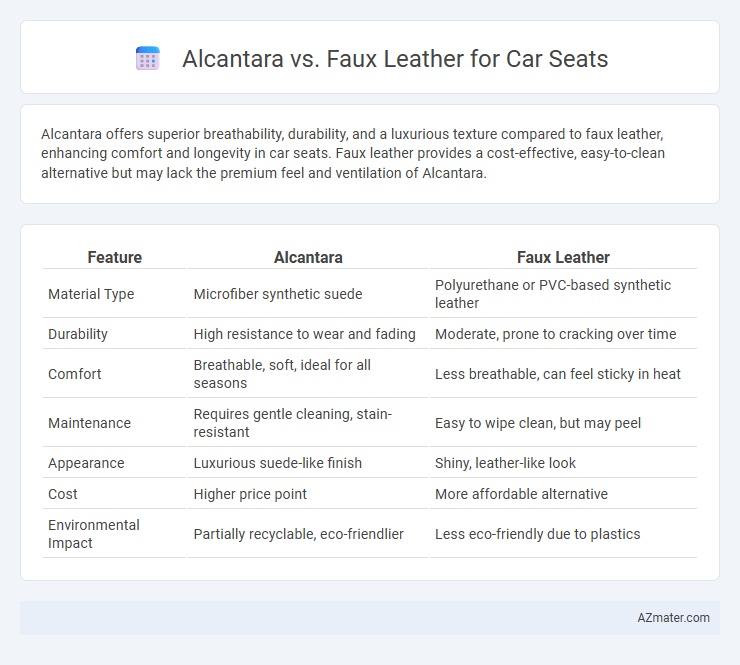Alcantara offers superior breathability, durability, and a luxurious texture compared to faux leather, enhancing comfort and longevity in car seats. Faux leather provides a cost-effective, easy-to-clean alternative but may lack the premium feel and ventilation of Alcantara.
Table of Comparison
| Feature | Alcantara | Faux Leather |
|---|---|---|
| Material Type | Microfiber synthetic suede | Polyurethane or PVC-based synthetic leather |
| Durability | High resistance to wear and fading | Moderate, prone to cracking over time |
| Comfort | Breathable, soft, ideal for all seasons | Less breathable, can feel sticky in heat |
| Maintenance | Requires gentle cleaning, stain-resistant | Easy to wipe clean, but may peel |
| Appearance | Luxurious suede-like finish | Shiny, leather-like look |
| Cost | Higher price point | More affordable alternative |
| Environmental Impact | Partially recyclable, eco-friendlier | Less eco-friendly due to plastics |
Introduction to Alcantara and Faux Leather
Alcantara is a premium synthetic material composed of microfiber polyester and polyurethane, known for its soft texture, breathability, and durability, making it ideal for luxury car seats. Faux leather, also called synthetic leather or PU leather, is a man-made material designed to mimic the appearance and feel of genuine leather while offering greater affordability and easier maintenance. Both materials provide distinct benefits in automotive interiors, with Alcantara favored for comfort and grip, while faux leather is popular for its cost-effectiveness and water resistance.
Material Composition and Origin
Alcantara consists of a blend of approximately 68% polyester and 32% polyurethane, originating from Italy, known for its durability and breathability in automotive upholstery. Faux leather, or synthetic leather, is typically made from a polyvinyl chloride (PVC) or polyurethane (PU) base layered over a textile fabric, designed to mimic genuine leather at a lower cost. The distinct material composition influences factors like texture, maintenance, and environmental impact, with Alcantara praised for its luxurious feel and faux leather valued for its leather-like appearance and water resistance.
Appearance and Texture Comparison
Alcantara features a soft, suede-like texture with a matte finish that enhances luxury car interiors, while faux leather offers a smooth, glossy surface resembling genuine leather but lacks breathability. Alcantara's fine microfiber structure provides a plush, tactile feel and resists temperature extremes better than faux leather, which can become sticky or stiff in heat or cold. The rich, natural appearance of Alcantara contrasts with the more uniform, synthetic look of faux leather, impacting the overall aesthetic appeal of car seats.
Comfort and Breathability
Alcantara offers superior comfort and breathability compared to faux leather due to its microfiber composition that allows better air circulation and moisture absorption, reducing heat buildup during long drives. Faux leather, made from synthetic materials, tends to trap heat and sweat, leading to discomfort, especially in warmer climates. The breathable nature of Alcantara enhances driving experience by maintaining a cooler and drier seat surface.
Durability and Longevity
Alcantara offers superior durability compared to faux leather, resisting wear, fading, and cracking even after years of use in car seats. Its unique microfiber composition maintains texture and breathability, contributing to longer-lasting comfort and appearance. Faux leather tends to degrade faster, often peeling or cracking under constant exposure to heat and friction, reducing its lifespan significantly.
Maintenance and Cleaning Requirements
Alcantara car seats require gentle maintenance with a soft brush or vacuum to remove dust and occasional spot cleaning using mild soap and water solutions, avoiding harsh chemicals. Faux leather seats offer easier cleaning through regular wiping with a damp cloth and can be treated with specialized vinyl or leather conditioners to prevent cracking and peeling. Both materials benefit from prompt attention to spills, but Alcantara demands more delicate care due to its fabric-like texture compared to the more durable and moisture-resistant surface of faux leather.
Cost and Value Analysis
Alcantara car seats typically cost between $50 and $100 per yard, reflecting their premium durability, breathability, and luxurious feel, whereas faux leather ranges from $10 to $30 per yard, offering a more affordable yet less breathable and less durable alternative. Although Alcantara has a higher upfront cost, its resistance to wear, staining, and fading often results in longer-lasting value and reduced replacement expenses over time. Faux leather may save initial expenses but may require more frequent repairs or replacements due to cracking and peeling, affecting overall long-term cost-effectiveness.
Environmental Impact and Sustainability
Alcantara, made from a blend of polyester and polyurethane, offers a more sustainable alternative to traditional faux leather by utilizing renewable energy in its production and generating less waste. Faux leather, often composed of polyvinyl chloride (PVC) or polyurethane (PU), has a significant environmental footprint due to the release of toxic chemicals and non-biodegradable nature. Choosing Alcantara for car seats supports lower carbon emissions and promotes recyclability, aligning better with eco-friendly automotive interior standards.
Popular Car Brands and Applications
Alcantara is favored by luxury car brands such as Audi, Lamborghini, and Porsche for premium seat upholstery due to its durability, breathability, and upscale appearance, often found in high-performance and sports models. Faux leather is commonly used by mainstream brands like Toyota, Ford, and Honda, offering an affordable, easy-to-clean alternative that suits everyday vehicles and family cars. Both materials facilitate customization and comfort but cater to different market segments and consumer preferences.
Which Car Seat Material Should You Choose?
Alcantara offers superior breathability, durability, and a premium feel compared to faux leather, making it ideal for car seats in luxury and performance vehicles. Faux leather provides a cost-effective, easy-to-clean alternative with a wide range of colors and textures but may lack breathability and longevity under heavy use. Choosing between Alcantara and faux leather depends on prioritizing comfort and durability versus budget and maintenance convenience for your car seats.

Infographic: Alcantara vs Faux Leather for Car Seat
 azmater.com
azmater.com